
The Atlanta Gladiators concluded their 2024-25 regular season with a record of 28 wins, 35 losses, and seven overtime losses, totaling 65 points. They finished in 12th place in the Eastern Conference and 25th overall in the league. While the team did not qualify for the playoffs, the season provided opportunities for growth and development that will guide their approach in the coming year.
Team Statistics
After 72 games, the Gladiators recorded 188 goals for and 248 goals against, resulting in a -60 goal difference. Their win percentage was 38.90%, reflecting the struggles they faced in several areas. The team scored 32 goals on the power play out of 222 power play opportunities, resulting in a 14.4% power play percentage, and killed 185 penalties out of 231 opportunities, with a penalty kill percentage of 80.1%.
Their home record stood at 17-13-4-2, while their road record finished at 11-22-3-0. The Gladiators also posted four overtime wins, seven overtime losses. They had two shootout wins with two shootout losses.
Head-to-Head Matchups
Atlanta’s record against each opponent paints a clear picture of where they found success—and where they struggled—over the course of the season:
- Divisional Battles: The Gladiators split their season series with Savannah (5-5-1-0) and posted a winning mark against Orlando (5-3-2-0).
- Tough Tests: Florida proved a stumbling block, as Atlanta went 0-6-1-0 against the Everblades. Greenville was also a challenge, with a 4-7-0-2 record.
- Strong Spot: The team swept the Indy Fuel (2-0-0-0) to kick off the season,
- Balanced Series: They split head-to-heads with Jacksonville (3-4-1-0) and Savannah (5-5-1-0), showing they could hang but needed to find that extra edge in tight matchups.
- Home-Ice Edge: Most of those wins—like the 5 victories over Orlando—came at home, underscoring the importance of defending the coliseum next season.
These head-to-head results highlight which rivals the Gladiators can target early in the year for momentum—and which matchups will require strategic tweaks to flip those series in their favor.
Improvements from 2023-24 to 2024-25
Special Teams: The Gladiators made strides in their special teams performance. Their penalty kill improved to 80.1%, compared to 79.3% in 2023-24, showing a solid upward trend in successfully killing penalties. The power play percentage remained consistent at 14.4% (compared to 14% last season), maintaining a comparable level of performance. The slight improvement in penalty killing indicates progress in this crucial area.
Defensive Improvement: While the team’s overall goals against was 248 (up from 264 in 2023-24), the Gladiators showed improvement defensively, particularly in reducing penalty minutes. Their total PIM was 716 this season, which was a decrease from 750 last year, suggesting a cleaner style of play with fewer penalties.
Road Performance: Though still a challenge, the Gladiators made improvements in their road record, going 11-22-3-0 this year compared to 15-24-2-1 last season. While the road record still needs significant improvement, it shows the team has made small gains, and with further adjustments, they can become more competitive away from home.
Atlanta Gladiators 2024–25 Season Honors
Offensive Team MVP: Cody Sylvester
Cody Sylvester was the Gladiators’ driving force all season long, appearing in 65 games and putting up a 0.72 points-per-game pace. He finished with 24 goals and 23 assists (47 points), including eight power-play tallies and nine power-play assists—underscoring his role as Atlanta’s primary man-advantage catalyst. Sylvester led the club in game-winning goals (6) and first goals (6), showing up in the most critical moments. With 181 shots on goal (2.78 SOG/G), he consistently pressured opponents, while his one unassisted tally highlighted his nose-for-the-net instincts. Whether sparking the attack or sealing victories, Sylvester’s combination of volume shooting, special-teams production, and clutch scoring made him a clear choice for Offensive Team MVP.
As an alternate captain, Sylvester was a key part of Atlanta’s offense all season long. He had a knack for stepping up in big moments—whether it was sparking a comeback, setting up a crucial play, or making an impact on the power play. His ability to create chances kept the team’s attack moving, and his leadership helped steady the group when games got tight. Sylvester didn’t just put up points—he drove the pace and helped set the standard every time he hit the ice.

Photo: Taylor Trebotte | Inside the Rink
Defensive Team MVP: Derek Topatigh
As an alternate captain and steadying force, Derek Topatigh was the backbone of Atlanta’s defense. He suited up for 71 games, logging a team-leading 45 points (0.63 PTS/G) from the back end, including two power-play goals and 16 power-play assists that fueled the man-advantage. Topatigh unleashed 189 shots from the point (2.66 SH/G), using his heavy shot to create second-chance opportunities and keep the pressure on in the offensive zone. His two-way savvy was evident in a +/– rating of –5 despite facing tough matchups, and his lone overtime goal proved he could deliver in clutch moments. With 52 penalty minutes, Topatigh balanced physicality and discipline, anchoring penalty-kill duties while still contributing offensively. His leadership, poise under pressure, and all-around game make him a clear choice for Defensive Team MVP.
Topatigh exemplified what it means to lead from the back end. His leadership wasn’t only about his point totals or being the top-scoring defenseman. It was his ability to set a standard of play that influenced the entire team. On the ice, Topatigh was the defenseman the Gladiators turned to in all situations—he was a key part of special teams, a threat on the power play, and an anchor for the team’s defense. His contributions provided stability and poise when things got tough.
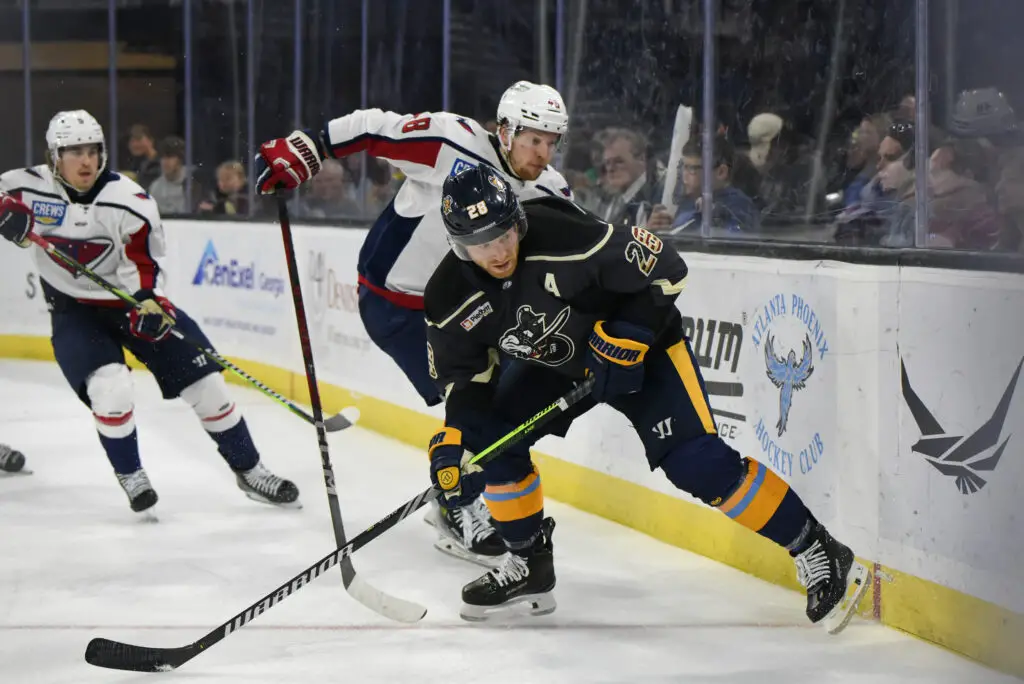
Photo: Andrew Fielder | Inside the Rink
Standouts: Top Gladiators Beyond the MVPs
While Cody Sylvester and Derek Topatigh rightfully earned the nods as team MVPs for forward and defenseman this season, there were several other standout players who quietly made a big impact. Here’s a look at the top three forwards and defensemen from the 2024–25 campaign—not including the MVPs—but absolutely worth a stick tap for their contributions on both ends of the ice.
Top 3 Forwards
Jackson Pierson was a steady and reliable presence throughout the season, leading all remaining forwards with 37 points in 72 games. His 11 goals and 26 assists showcased his ability to produce consistently across all situations. Pierson’s four power-play goals reflected his ability to thrive in key moments, while his well-rounded game contributed not just at even strength but also on special teams. Whether he was setting up plays or finishing them, Pierson’s versatility and dependability made him a cornerstone of the Gladiators’ forward group.
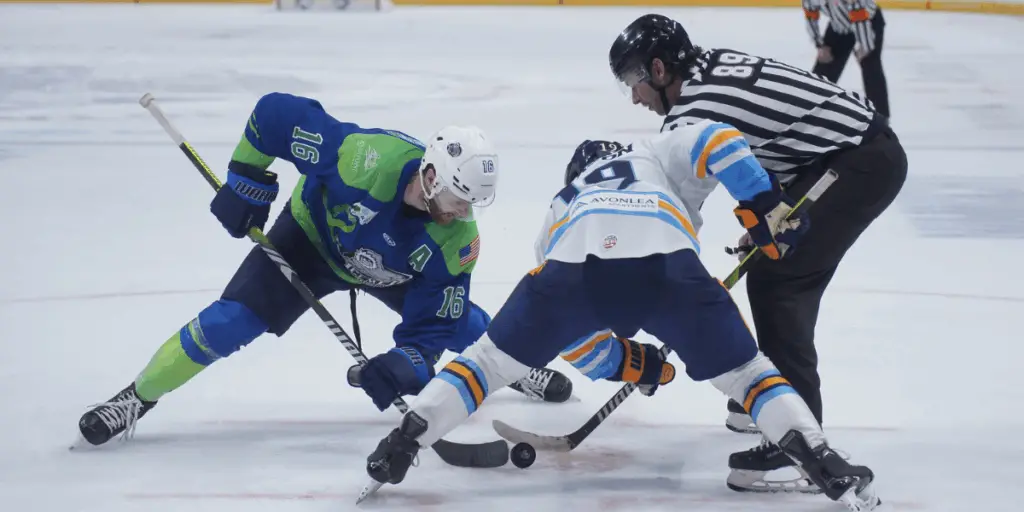
Photo: Andrew Fielder | Inside the Rink
Joey Cipollone brought a much-needed spark and offensive balance to the Gladiators, finishing the season with an impressive 15 goals and 19 assists in 68 games. His ability to chip in across all situations—from the power play to even registering a shorthanded goal—made him an indispensable all-around forward. Cipollone’s energy and consistency were a driving force in the team’s offensive attack, making him one of the most reliable and versatile players on the roster.
Alex Young proved to be an efficient offensive contributor after joining the Gladiators in March. In 11 games with Atlanta, he registered four goals, four assists (8 points). His time with the Atlanta Gladiators was valuable, as he added important depth to the forward group. Young showcased his offensive abilities and consistently stepped up when needed, providing a solid spark to the team’s attack.
Shot Volume Analysis – Forwards
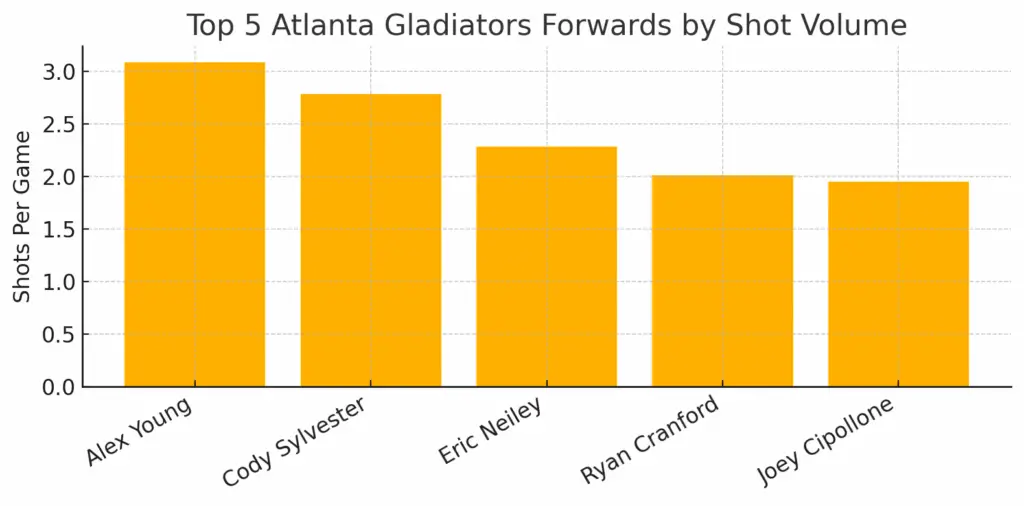
Here are the Top 5 Atlanta Gladiators forwards by shots per game:
- Alex Young – 34 shots in 11 GP → 3.09 S/G*
- Cody Sylvester – 181 shots in 65 GP → 2.78 S/G
- Eric Neiley – 103 shots in 45 GP → 2.29 S/G
- Ryan Cranford – 141 shots in 70 GP → 2.01 S/G
- Joey Cipollone – 133 shots in 68 GP → 1.96 S/G
*includes only data from after trade to Atlanta. Young’s overall shot volume was 2.65 between both teams which still kept him in the top five rankings landing in second behind Cody Sylvester.
Penalties vs Production

The scatterplot above maps each forward’s discipline versus production:
- Horizontal axis: Penalty minutes per game (PIM/GP)
- Vertical axis: Points per game (PTS/GP)
Key Takeaways:
- Eric Neiley stands out with the highest PTS/GP (0.76) but also the highest PIM/GP (0.73), underscoring his all-action style.
- Cody Sylvester balances strong production (0.72 PTS/GP) with moderate penalty trouble (0.49 PIM/GP).
- Alex Young delivers a solid 0.59 PTS/GP while remaining amongst the cleanest players (0.33 PIM/GP).
- Easton Armstrong and Randy Hernández anchor the lower-left: modest production paired with low penalty rates—ideal for roles requiring discipline.
With Eric Neiley now hanging up his skates, his legacy shines even brighter. Over a relentless career, he averaged 0.76 points per game and wasn’t shy about mixing it up—0.73 penalty minutes per outing show he brought as much edge as offense. Even in retirement, Neiley’s reputation as the Gladiators’ ultimate disruptor endures: the clutch playmaker who never backed down from a battle in the corners, the momentum-shifter who could light the lamp and defend his teammates with equal ferocity. His impact—both on the scoresheet and in the rink’s fiercest moments—sets the bar for the next generation of Gladiators.
Alex Young deserves some serious credit for quietly carving out a sweet spot between creativity and composure. Posting 0.59 points per game, he was one of the squad’s most efficient playmakers—yet he stayed out of the box, averaging just 0.33 penalty minutes each night. That means Young wasn’t wasting valuable ice time in the sin bin; instead, he was orchestrating rushes, threading tape-to-tape passes, and jumping into scoring lanes without missing a shift. In an era where physicality is prized, Young shows you can contribute offense at a high level while maintaining discipline—earning the trust of coaches to key roles without ever skating on thin ice.
Top 3 Defensemen
Anthony Firriolo led all eligible defensemen in +6 rating and finished second on the team with 19 points (4G, 15A) in 51 games. His poise with the puck and exceptional puck movement were vital in stabilizing the Gladiators’ defense, helping transition the play effectively and create offensive opportunities from the back end. Firriolo’s steady presence and ability to read the game made him a key player in both ends of the ice, providing much-needed balance and control throughout the season.

Photo: Taylor Trebotte | Inside the Rink
Jeremy Hanzel provided reliable offensive support from the blue line, finishing the season with 22 points from 3 goals and 19 assists in 61 games. His keen passing and sharp offensive reads were crucial in the team’s transition game, helping move the puck quickly and efficiently up the ice. Hanzel’s ability to contribute to the offense while maintaining solid defensive play made him a valuable asset on the back end, adding a dynamic element to the Gladiators’ game.
Andrew Jarvis brought a unique blend of grit, toughness, and timely scoring to the Gladiators’ defensive corps, recording six goals and seven assists in 59 games. His fearless play on the penalty kill set him apart, as he contributed two shorthanded goals, making him a constant threat even when the team was down a man. Jarvis wasn’t just about scoring; he played a critical shutdown role, using his physicality to disrupt opposing offenses and clear the crease. His tenacity and ability to rise to the occasion made him an invaluable piece of the Gladiators’ defense.
Shot Volume Analysis – Defensemen
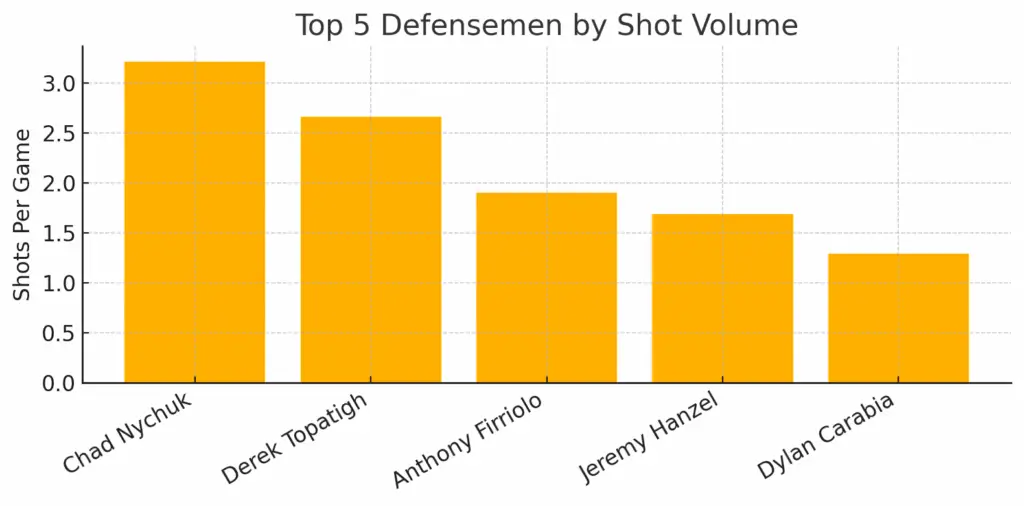
Here are the shots-per-game rates for your defense corps, sorted and with the top five highlighted:
- Chad Nychuk leads with 61 shots in 19 games: 3.21 S/G
- Derek Topatigh follows: 189 S in 71 GP → 2.66 S/G
- Anthony Firriolo: 97 S in 51 GP → 1.90 S/G
- Jeremy Hanzel: 103 S in 61 GP → 1.69 S/G
- Dylan Carabia: 75 S in 58 GP → 1.29 S/G
Defensemen: Offensive Impact and Shot Volume
Atlanta’s blue line played a pivotal role in driving play from the back end, blending veteran leadership with up-and-coming talent. Together, this group delivered the balanced two-way presence the Gladiators needed all season.

The chart above illustrates how Atlanta’s blueliners balanced offense and volume:
- Derek Topatigh stands out as the most dynamic defender, notching over 0.6 points per game while firing nearly 2.7 shots each night—an ideal two-way workhorse.
- Anthony Firriolo and Jeremy Hanzel both hover around 0.36 points per game but are more than willing to jump into the rush, each averaging between 1.7–1.9 shots per outing.
- Andrew Jarvis brings veteran stability, chipping in a point roughly every five games with a steady one shot per night.
- Zach Yoder provides depth minutes with a modest 0.13 PTS/G and a supportive 0.70 SOG/G.
Derek Topatigh spearheaded the charge, averaging an impressive 0.63 points per game alongside nearly 2.7 shot attempts each outing—equipment room staples for both power play and even strength. Close behind, Anthony Firriolo and Jeremy Hanzel each posted roughly 0.36 PTS/G while consistently jumping into the rush for 1.7–1.9 shots per night. Meanwhile, Andrew Jarvis provided steady reliability, chipping in a point every five games with a dependable one shot per contest. Even in a depth role, Zach Yoder chipped in with strong support minutes, logging 0.70 shots per game.
This grouping highlights the balance of experience, offensive flair, and depth on Atlanta’s blue line—key factors in driving transition play and generating second-chance opportunities throughout the season.
Clutch Moments
In the heat of the moment, a single play can turn the tide—and for Atlanta, a handful of clutch performers did just that all season long. From igniting the attack with the first goal, to adding insurance late in games, to burying game-winners under pressure and even delivering sudden-death overtime strikes, these players were the ones who made every shift count. Below, we break down the top five in each of those pivotal categories—first goals, insurance goals, game-winning goals, and overtime winners—to show exactly who rose to the occasion when it mattered most.
First Goals set the tone:
• Cody Sylvester – 6 openers
• Joey Cipollone – 4
• Eric Neiley & Alex Young – 3 each
• Carson Denomie – 2
Insurance Goals provided late-game cushion:
• Sylvester – 2
• Neiley – 1
Game-Winners under pressure:
• Sylvester – 9
• Neiley – 4
• Denomie & Cranford – 2 each
• Cipollone – 1
Overtime Heroes in sudden-death:
• Denomie – 3 winners
• Cipollone – 2
• Sylvester & Campbell – 1 each
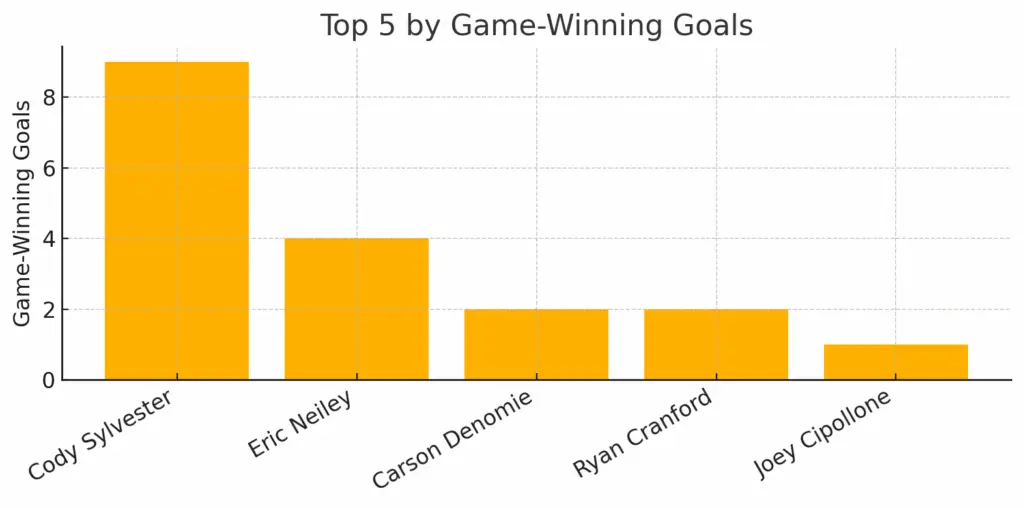
Sudden Death Specialists
Carson Denomie remains the overtime king, turning three sudden-death chances into victories, with Cipollone’s two winners coming in equally high-pressure moments. Sylvester and Campbell each delivered that clutch extra-time dagger once, proving that Atlanta’s depth in late-game situations was a season-defining strength.
How The Goals Were Made
Together, these nuanced goal types show not just volume but timing—who sparks the attack, who seals leads, and who delivers in the most dramatic moments. We can instantly see which players excelled in each clutch category.
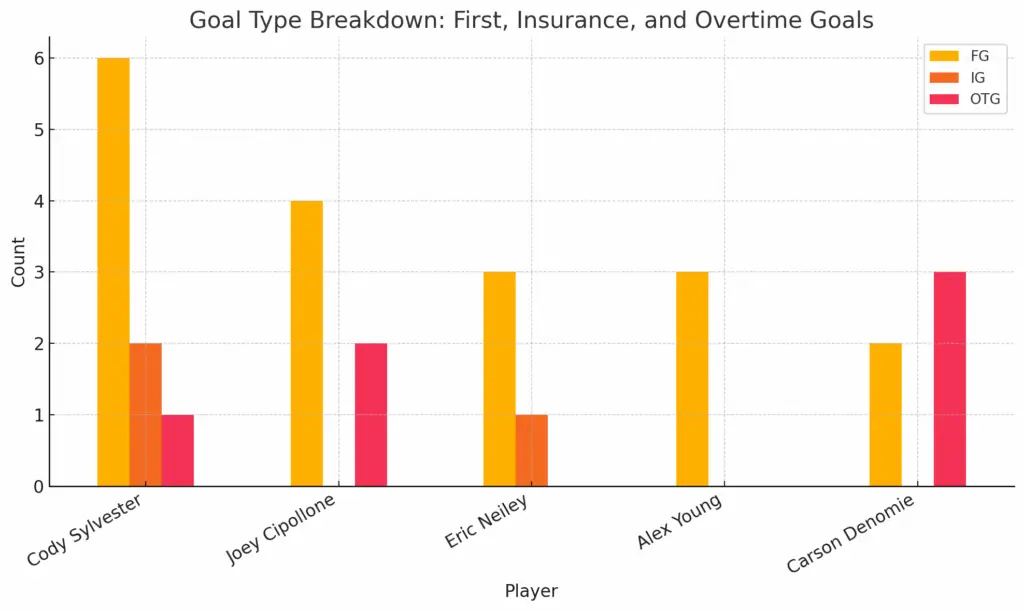
Goaltending
As we’ve seen, Atlanta’s skaters consistently delivered in the clutch—now let’s turn our attention to the last line of defense. Between the pipes, Drew DeRidder and Ethan Haider shouldered heavy workloads and stood tall in goal, often turning back waves of shots and keeping the Gladiators in every contest. Here’s how their season-long performances shaped the team’s success.
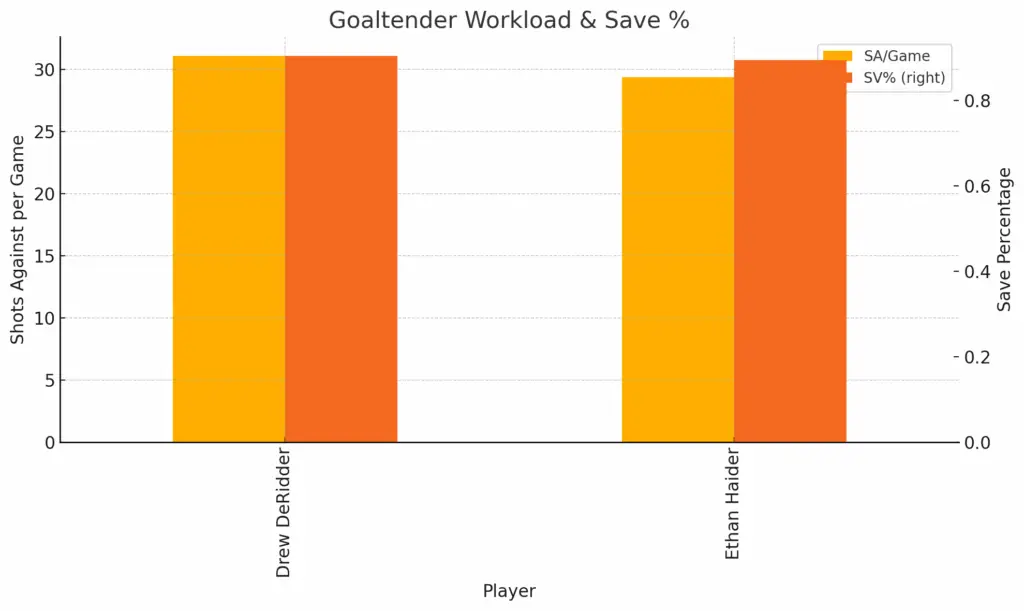
- Workload: DeRidder faced an average of 31.1 shots per game, while Haider saw 29.4—both well above league average, showcasing their heavy defensive burdens.
- Consistency: With save percentages north of .890 despite those shot volumes, DeRidder (.904) and Haider (.894) anchored the crease on back-to-back nights, rarely missing starts and delivering key stops.
- Shutouts: Each netminder delivered multiple shutouts (DeRidder 3, Haider 4), illustrating their ability to steal games when needed.
Together, this duo’s durability and clutch performances between the pipes gave fans confidence that, regardless of the onslaught, the net was in safe hands.
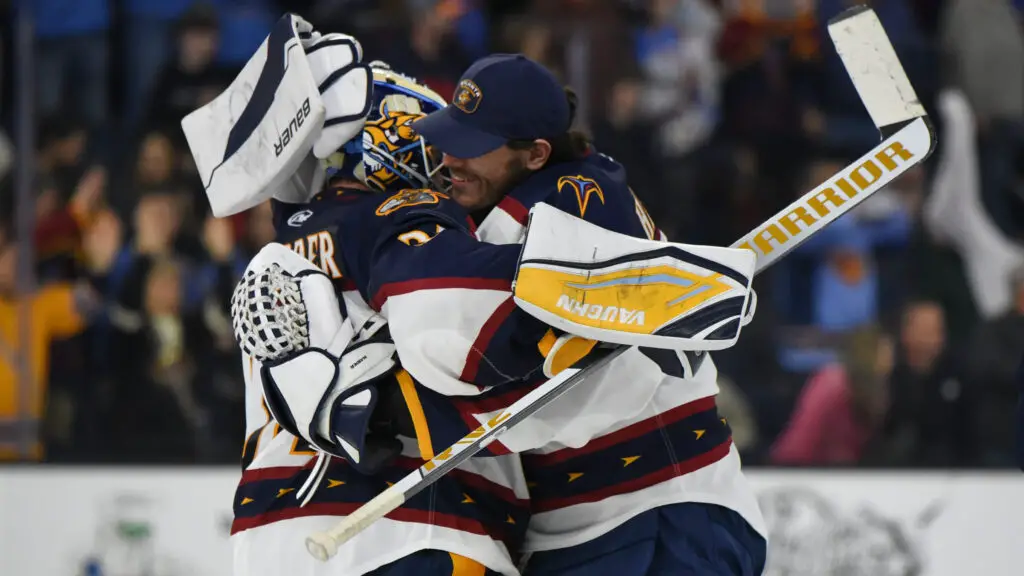
Photo: Taylor Trebotte | Inside the Rink
Drew DeRidder played in 37 games, posting a 10-19 record with a 3.02 GAA and a .904 SV%. He faced 1,150 shots and allowed 110 goals over 2,186 minutes of play. DeRidder contributed with one shootout win and a shootout loss. While his performance wasn’t enough to keep the Gladiators consistently in the win column, his efforts were crucial in several tight games.
Ethan Haider had a strong season, appearing in 36 games and finishing with an 18-15 record. He posted a 3.17 GAA and a .894 SV%, saving 1,059 shots and allowing 112 goals across 2,116 minutes. Haider also recorded one shootout win and one shootout loss. Haider provided a steady presence in the crease when called upon. Despite facing a slightly higher goal count than DeRidder, his overall performance helped keep the Gladiators competitive in several matchups.
Writer’s Picks: The Heart-and-Hustle Guys
These were the kind of players who made a difference in the grind of the season. Whether it was showing up every night, stepping into tough matchups, or simply outworking expectations, these guys earned their place on my list.
Forward – Carson Denomie
Carson Denomie quietly embodied the term by showing up night after night and delivering key contributions without fanfare. In all 72 games, he chipped in 29 points with 12 goals and 17 assists (0.40 PTS/G) and generated 104 shots (1.44 S/G), providing a steady secondary scoring option behind the top line. His knack for late-game heroics—three overtime winners and two game‐winning goals—proved invaluable in tight contests, yet he rarely drew the spotlight. Denomie’s work ethic, clutch scoring, and willingness to play physical minutes made him a true glue guy—an essential piece who kept lines rolling and lifted morale whenever the team needed a spark. Whether he was blocking lanes, forechecking, or providing that clutch tally, Denomie’s unwavering effort epitomized heart and hustle.
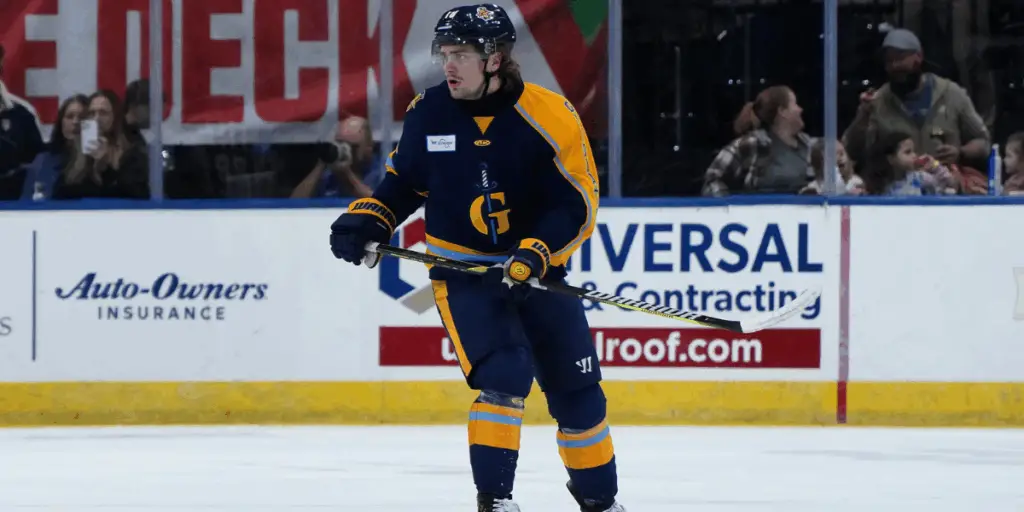
Photo: Andrew Fielder | Inside the Rink
Forward – Easton Armstrong
Across 51 games, Armstrong totaled eight goals and 13 assists (21 points, 0.41 PTS/G) while consistently logging responsible defensive-zone minutes. He fired 84 shots on goal (1.65 S/G), showing a willingness to drive the net and create traffic. More importantly, Armstrong’s relentless forechecking, back‐checking effort, and zero‐fear approach in the corners embodied the blue‐collar mentality every coach covets. Though his numbers don’t jump off the scoresheet, his shift‐after‐shift work ethic—creening opposing defensemen, blocking passing lanes, and supporting teammates on every rush—makes him a true heart‐and‐hustle player who lifted the entire lineup.
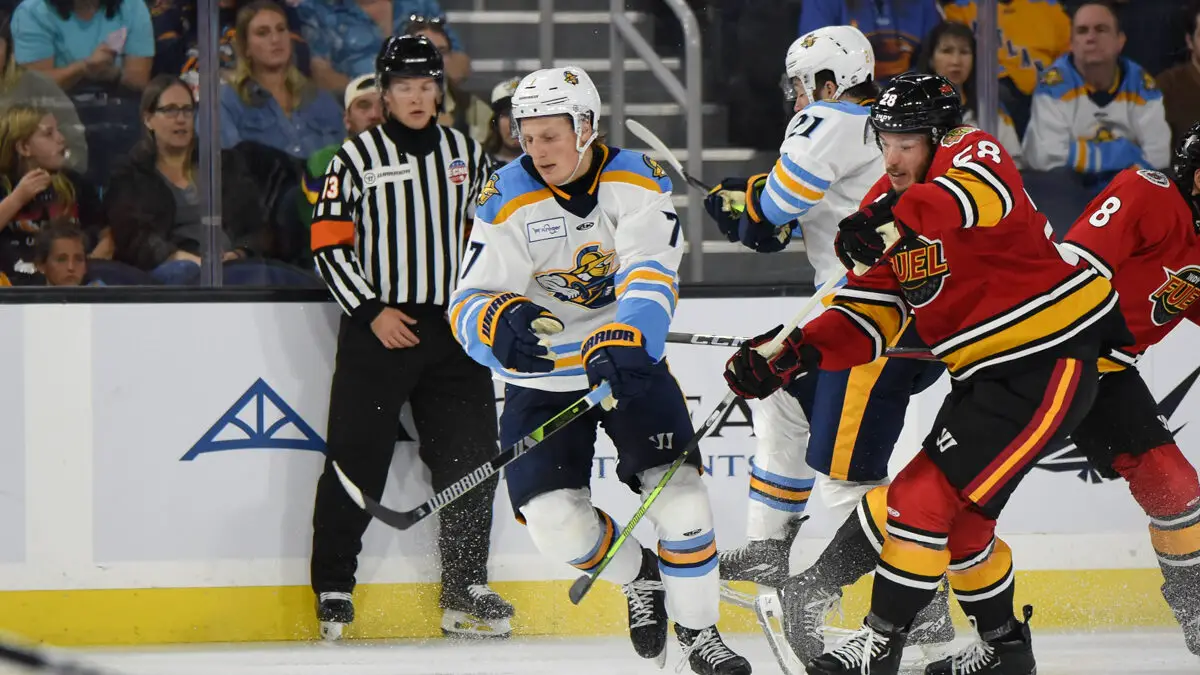
Photo: Taylor Trebotte | Inside the Rink
Defenseman – Brenden Datema
Brenden Datema might be the true “dark horse” of Atlanta’s blue line. Datema’s value lies in a blend of toughness and opportunism that doesn’t always show up in the box score. In 48 games he racked up 78 penalty minutes—an average of 1.63 PIM per night—demonstrating his willingness to drop the gloves, throw big hits, and protect the paint in front of the net. Yet Datema also managed 37 shots on goal (0.77 SOG/G), proving he can jump into the play and create chances when needed. That combination—an agitator who wears down opponents and still finds ways to get pucks toward the crease—defines the kind of gritty defenseman every team needs. More than anything, his relentless board battles, shot blocks, and fearless support in front of the net embodied pride and grit. Day in and day out, Datema’s refusal to back down and constant effort in the dirty areas made him the true heart-and-hustle backbone of Atlanta’s defensive corps.
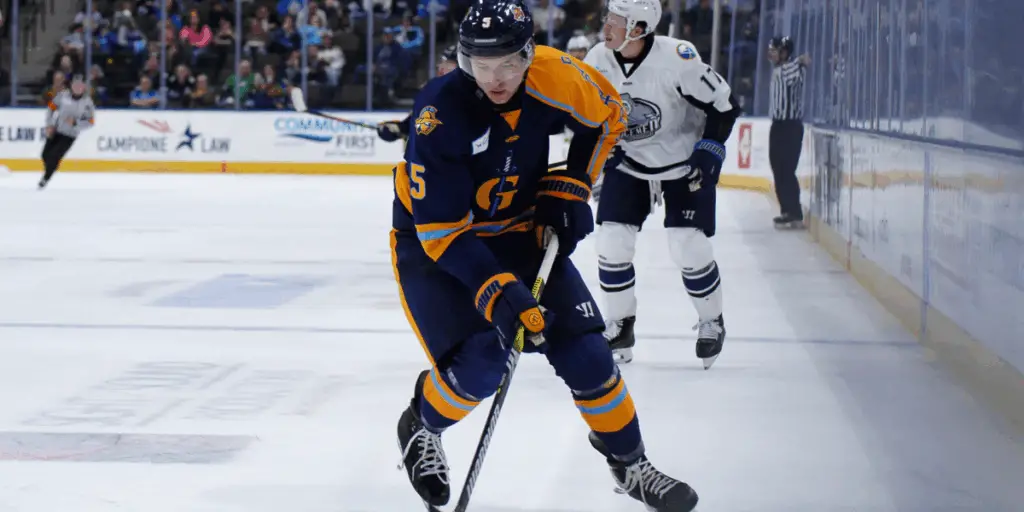
Photo: Andrew Fielder | Inside the Rink
These players showed the most consistent leadership and game-changing contributions throughout the season.
My Line Picks
Here’s a look at how last season’s data suggests we could have structured Atlanta’s roster—acknowledging that some pieces may return, some may move on, and roles will inevitably shift. Using shot volume, scoring impact, and defensive reliability as our guideposts, these “My Line Picks” for lines and pairings illustrate the combinations that maximized puck pressure, chance quality, and crease protection. As the roster takes shape for next year, this framework offers a starting point for blending firepower and stability in every situation. Together, these “My Line Picks” combinations blend firepower, playmaking, and defensive assurance—ensuring our netminders see pucks cleanly while the offense consistently generates high-quality chances.
With Eric Neiley’s retirement, last season’s numbers also point to several internal options and emerging talents who could fill his dynamic top-line role next year. Alex Young’s full-season 0.59 PTS/G and hefty shot volume (2.65 S/G)—which surged to 3.09 S/G in his Atlanta stint—makes him the frontrunner to slide into Neiley’s spot beside Sylvester and Pierson. Behind him, Easton Armstrong (0.41 PTS/G) and Randy Hernández (0.31 PTS/G, low PIM) offer reliable secondary scoring and disciplined two-way play, ideal for the second unit or matchup minutes. And don’t forget the high-upside call-ups: Jordan Frasca and Alexander Campbell’s point-per-game efficiency, give coaches tempting “wild cards” to inject instant offense. By blending proven shot-producers with trusted depth scorers—guided by last year’s data—the Gladiators can sustain puck pressure and clutch scoring even without Neiley on the roster.
Top Forward Lines
When it comes to safeguarding the core of this roster, we would lock in these proven playmakers, workhorses, and backbone contributors who drive our identity on every shift.
| Line | LW | C | RW | Why It Works |
|---|---|---|---|---|
| 1st | Jackson Pierson | Cody Sylvester | Eric Neiley* | Elite shot-volume trio (2.0+, 2.78, 2.29 S/G) for top-line firepower and constant pressure. |
| 2nd | Carson Denomie | Alex Young | Joey Cipollone | Balanced mix of Young’s discipline/vision, Denomie’s speed and OT flair, and Cipollone’s clutch knack. |
| 3rd | Easton Armstrong | Randy Hernández | Ryan Cranford | Secondary scoring depth and physicality—ideal for defensive zone starts and energy shifts. |
Strong Defensive Pairings
| Pair | LD | RD | Why It Works |
|---|---|---|---|
| A | Derek Topatigh | Anthony Firriolo | Top two by PTS/G and SOG/G—great for jump-in offense and reliable puck management. |
| B | Jeremy Hanzel | Andrew Jarvis | Hanzel’s secondary scoring plus Jarvis’s veteran shutdown presence give the crease consistent look clarity. |
| C | Dylan Carabia | Zach Yoder | Youthful energy and depth minutes—perfect for lower-pressure situations and keep legs fresh. |
*Retired
If we can bring back all contributors, three deserve extra focus. Alex Young would slot into Neiley’s old top-line spot—his creativity, shot volume, and relentless effort can immediately jump-start our top unit. Carson Denomie is the go-to for late-game heroics and high-leverage shifts; his clutch scoring and non-stop forecheck make him indispensable in overtime and tight contests. Brenden Datema anchors the third defensive pairing with his physicality and board-battle tenacity, protecting the crease and freeing up our puck movers to transition out of trouble—all three players help preserve our balance of firepower, clutch play, and blue-collar grit next year.
Atlanta’s Unsung Heroes
In every lineup, it’s often the overlooked contributors—those depth players flying under the radar—who quietly tip the balance in their team’s favor. My “Unsung Heroes” are the rookies and role-players whose per-game efficiency outpaced their ice-time, delivering key points, energy, and momentum in limited action. Here’s a look at the players who maximized every shift and proved that impact isn’t always measured by raw totals.
Jordan Frasca quietly etched his name into the Gladiators’ season narrative from the moment he stepped onto the ice. In just five appearances with Atlanta, he produced five points—averaging a goal or assist each time he suited up. Frasca’s knack for finding seams and finishing plays made him an instant depth catalyst, forcing opponents to account for his presence even in limited action. His one-point-per-game pace underscores a player who maximizes every shift, embodying the kind of under-the-radar contributor who can tilt momentum and spark a lineup.
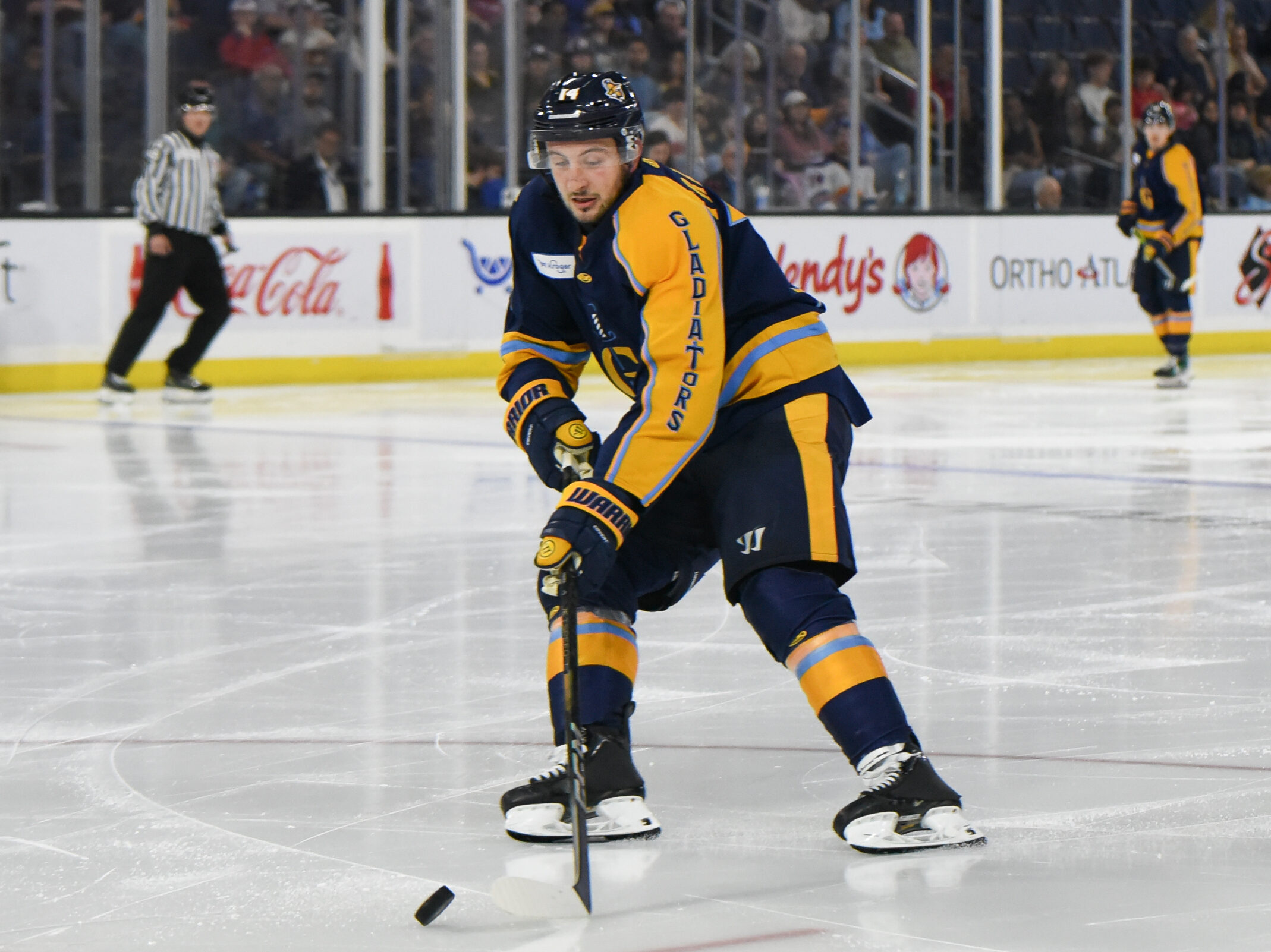
Photo: Andrew Fielder | Inside the Rink
Alexander Campbell mirrored that efficiency with equal impact. Also limited to five games, Campbell matched Frasca’s five-point output, demonstrating an uncanny ability to read puck movement and join the rush at just the right moment. His clutch instincts in transitional play and willingness to jump into scoring lanes made him a valuable surprise package. Campbell’s 1.00 PTS/G rate highlights a player who made every second count, reinforcing the Gladiators’ depth by delivering quality minutes and proving that sometimes the biggest contributions come from those you least expect.
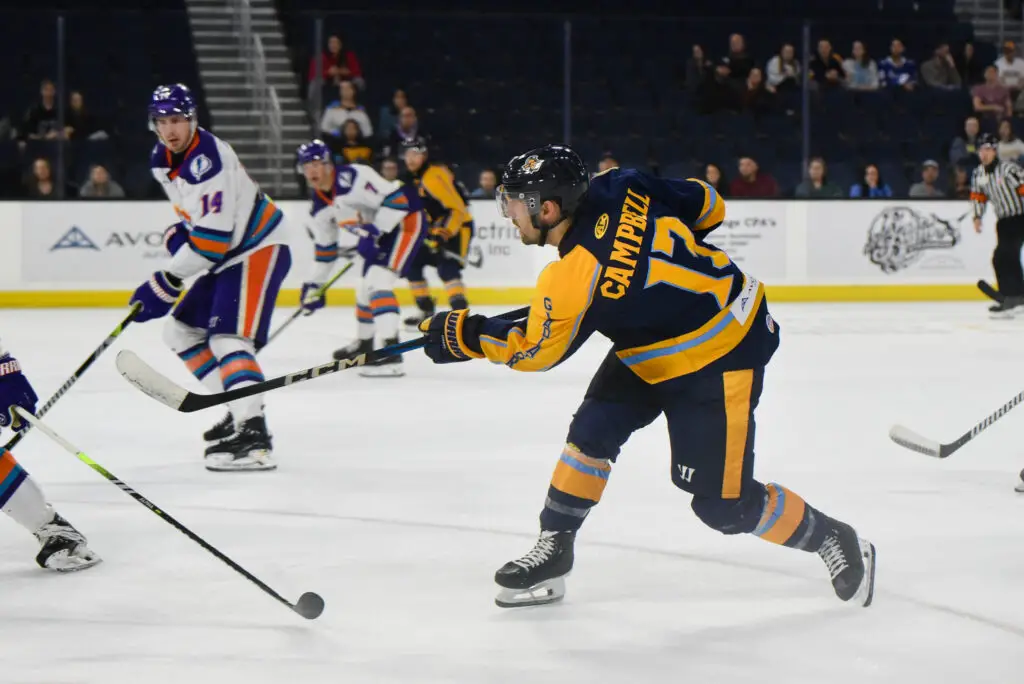
Photo: Andrew Fielder | Inside the Rink
Rookie to Watch – Connor Galloway
Connor Galloway made a memorable first impression in his rookie campaign. With five goals and 10 assists in 50 games, his offensive upside began to shine through—but it was his energy, hustle, and willingness to take on tough minutes that really turned heads. Whether it was chasing down pucks, crashing the net, or giving everything on the backcheck, Galloway played like a guy who wanted to earn his jersey every night. His first professional goal was a season highlight—not just for him, but for the fans who saw how much it meant to this Georgia native. If this year was the foundation, there’s a lot to be excited about moving forward for this talented hockey player.
Rookies Making Their Mark
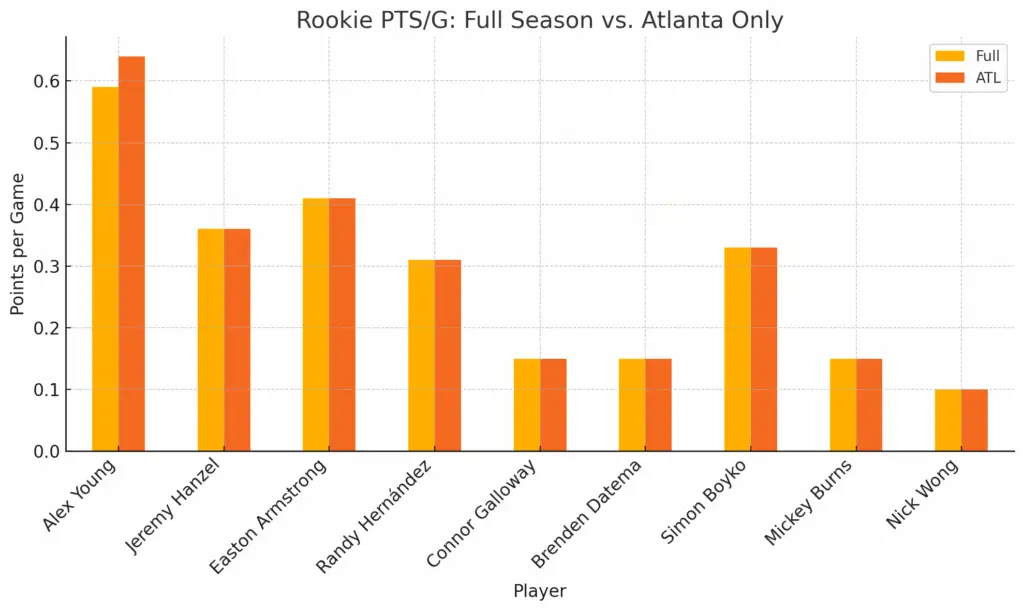
Atlanta’s freshman class carried their weight in both production and presence. Alex Young* topped the class at 0.59 points per game, emerging as a quietly reliable secondary scorer. Easton Armstrong (0.41 PTS/G) and Jeremy Hanzel (0.36 PTS/G) both carved out steady roles, contributing timely offense night in and night out. Randy Hernández chipped in a solid 0.31 PTS/G, rounding out the top performers. Even in more limited roles, Simon Boyko (0.33), Connor Galloway (0.15), Brenden Datema (0.15), Mickey Burns (0.15), and Nick Wong (0.10) flashed glimpses of promise, laying the groundwork for future seasons. Together, this active rookie class blended immediate impact with clear upside, underscoring why the Gladiators’ future is in good hands should any of these players return to the 2025-26 roster.
NOTE: Alex Young’s jump from 0.59 PTS/G over his full season to 0.64 PTS/G in an Atlanta sweater tells a clear story: he didn’t just maintain his rookie production—he elevated it. While his fellow first-year players hovered around the same output regardless of team, Young’s offensive pace and shot volume (up to 3.09 SOG/G in Atlanta from 2.65 full-season) surged once he joined the Gladiators. That uptick suggests a strong fit in Atlanta’s system—whether through power-play usage, linemate chemistry, or ice-time allocation—and marks him as the one rookie whose game truly took off midstream. In short, Young didn’t merely carry his scoring touch over; he dialed it up.
Iron-Men Durability
Only two skaters logged every shift this season, suiting up in all 72 games:
Jackson Pierson – 37 points (0.51 PTS/G)
Carson Denomie – 29 points (0.40 PTS/G)
This duo’s reliability was crucial—Pierson’s half-point average underlines his consistent scoring threat, while Denomie’s 0.40 PTS/G from a depth role showcases his steady two-way play. Having players who never miss a game builds team continuity and momentum, and these iron-men anchored Atlanta’s lineup night after night.

Coaching
While individual player performances certainly stood out, the coaching staff was instrumental in shaping the Atlanta Gladiators’ growth this season. Despite a difficult season, the coaching team provided unwavering leadership, both on and off the ice, ensuring that the Gladiators continued to improve throughout the year.
The coaching staff was consistent in their adjustments, especially in areas like defensive play and special teams. The penalty kill percentage showed noticeable improvement, a direct reflection of the team’s strategic preparation and focus. The Gladiators were more disciplined in their defensive zone, and the coaching staff played a key role in making that a priority. Their ability to adapt and tweak systems to maximize player strengths, particularly during tough stretches, was an invaluable part of the team’s development.
As the Gladiators look to the future, Matt Ginn will be stepping into the head coach role, following Derek Nesbitt’s transition to the front office. Ginn, who has been with the Gladiators as an assistant coach, brings a wealth of experience and a deep understanding of the team’s needs. His promotion represents a new chapter for the team, and the coaching staff is eager to continue fostering growth, developing young talent, and positioning the Gladiators for success in the seasons to come.
Focus Areas for 2025-26
As the Gladiators turned the page on 2024–25 and set their sights on the coming campaign, a few clear priorities emerge. Improving life on the road, tightening up defensively in the late stages, and building on the multi-line scoring depth will be critical. Equally important will be fostering leadership in the locker room, sharpening special-teams execution, and deepening community ties to keep the crowd behind the team. In the sections that follow, we’ll dive into each of these key focus areas—and show why getting them right could be the difference between making noise and making the playoffs.
Increase Scoring Chances
Hockey games aren’t won in just one period, and Atlanta’s numbers make that crystal clear. The Gladiators started strong—putting up 51 goals in the first frame—but also gave up 66, setting a tone of “see-saw” hockey. In the second period they managed 60 goals but allowed 86, then poured in a season-high 71 in the third—only to concede 87. Those late-game defensive lapses turned potential wins into tough losses. Even in overtime and shootouts, where every second feels huge, they were out-scored 4–7 and split the shootout 2–2.
On the shot clock, the story is much the same: Atlanta fired more pucks on net early (697 shots in period one vs. 724 against) and hung tough in the second (738–757), but saw that slim advantage slip away in the third (712–720). Over 72 games they averaged just 2.61 goals per outing (25th in the league) while giving up 3.44 (tied for 24th).
Why does this matter? It shows that—even with flashes of offensive firepower—Atlanta needs to tighten up in the middle and late stages to turn high-tempo starts into full-60-minute wins. For fans, it means keeping an eye on momentum shifts after the first intermission and cheering for that bend-but-don’t-break defensive effort to carry the Gladiators all the way to the final horn.
Protecting the Early Lead
When Atlanta jumped out to an early lead, it showed—those nights when the team was up after one period they went 16-6-2-1, and if they still led at the second intermission they won 18 of 23 games. But when they found themselves behind early, the season got a lot tougher: just five wins in 32 outings when trailing after the first, and only three victories once down after two. Even in tight, tied games they split their decisions, and on nights they out-shot opponents they managed a .500 record—but when the other team had more puck-carries, Atlanta went just 14-22-4-0. That truly tells the story: the Gladiators need to strike first and build momentum, because once they’re playing catch-up or losing the possession battle, the odds swing dramatically against them. Keeping the lead—or grabbing one early—is the key to turning good starts into more wins.
Streaks Tell the Story
The Gladiators’ season was defined as much by streaks as by individual performances. Atlanta endured a four-game winless skid (04/09→…), including an eight-game road winless stretch (03/09→…) and matching eight-game road losing run, underscoring how difficult it became to find traction away from home.
Game Highs
This season, Atlanta didn’t crack any of the league’s single-game records—no 10- or 11-goal outbursts, 20-assist nights, or 30-point affairs like some clubs managed—but that’s where the opportunity lies. The Gladiators topped out at solid, competitive outputs rather than record-setting ones, which tells us two things: when everything clicks they can hang with the best, and there’s plenty of room for those “breakout” nights that electrify the building. For fans, that means looking forward to seeing which players will be the first to push into those elite territory next season—whether it’s a 5-goal eruption, a 15-assist playmaking clinic, or a 20-save standout in net—because those are the nights that become lasting memories.
Road Performance
One of the biggest challenges for the Gladiators this season was their road record. Improving away from home should be a primary focus for the upcoming season. With only 11 road wins this year, the Gladiators will need to find ways to replicate their home success on the road, whether it’s by improving defensive structure, finding more consistent goal-scoring, or fostering stronger team cohesion in tough environments.
Defensive Consistency
Despite improvements in goals against compared to 2023-24, the Gladiators still allowed 248 goals this season, which highlights an area for growth. Strengthening the defensive zone coverage and ensuring better gap control can help lower the overall goals against next year. Establishing solid pairings and focusing on defensive discipline, particularly during key moments like late-period situations or in one-goal games, will be crucial.
Offensive Development
Offensive development was a clear bright spot in 2024-25—even if the overall goal total (188) ranked 25th, the way those goals were spread across the lineup gives real cause for optimism. Beyond the top guns (Sylvester’s 47 points, Young’s high-volume shooting), Atlanta got contributions up and down the roster: five different skaters averaged over 0.50 PTS/G, and another half-dozen chipped in at least 0.30. The power play held steady at 14.4%, but watch for growth there as more players—like Young and Pierson—learn to click on the man-advantage. Shot volume also ticked up in key stretches, with the team averaging over 30 attempts in periods two and three during winning streaks. In short, the Gladiators aren’t a one-line club; they’ve built an offensive foundation with depth, creating multiple avenues to attack—which will be crucial as they look to boost their league-ranked goal-for numbers next season.
Team Chemistry and Leadership
With the transition of Matt Ginn to head coach, team chemistry will be crucial moving forward. The leadership shown by Cody Sylvester and Derek Topatigh will be pivotal should both return next year, but the team must also focus on developing leadership from within. This will be especially important as Eric Neiley’s retirement leaves a leadership void. Neiley’s presence on the ice and in the locker room was a cornerstone for the Gladiators, and now the team will need to fill that gap.
As veteran voices like Eric Neiley ride off into retirement, the Gladiators will lean on their emerging core to fill the leadership void—and a few younger skaters are already primed to step up. Jackson Pierson has earned his “iron-man” reputation (72 GP) and steady 0.51 PTS/G, making him a natural candidate to wear an “A” next season. Alex Young’s quiet confidence and discipline, alongside his 3.09 SOG/G in Atlanta, give him the poise to rally the group on and off the ice. Easton Armstrong’s work-manlike style and ever-reliable 0.41 PTS/G mark him as a character player who leads by example in every shift. And don’t overlook Randy Hernández—his two-way savvy (0.31 PTS/G, low PIM) make him an solid choice as well. Together, these young Gladiators possess the consistency, character, and hometown pride to guide the club’s next chapter.
Encouraging younger players to take on more responsibility and keeping morale high will be essential as the Gladiators look to find their competitive edge next season. Looking to some of the newer players to step into leadership roles will certainly be a key area for this team.
Fan Support and Attendance
While fan attendance has remained solid, continuing to grow the fan base through community involvement, promotions, and fan engagement initiatives can help increase attendance, especially during the road-heavy stretches of the season. Fans are crucial to building momentum, and the Gladiators should continue to make them feel like a part of the team’s journey. Enhancing the game-day experience with new activities and community events could also provide a significant boost. With Derek Nesbitt’s new role as Director of Community Engagement in the front office, the Gladiators are positioned to strengthen their relationship with the community. His leadership in this area will be vital in creating new opportunities for fan interaction and developing lasting connections with the team.
In terms of fan support, the Atlanta Gladiators saw a slight increase in attendance this season compared to last. In the 2024-25 season, the team attracted 151,305 fans over 36 home games, averaging 4,203 fans per game. This marked a 35-fan increase from the 2023-24 season, where the Gladiators drew 150,039 fans, averaging 4,168 fans per game. While this shows positive growth, the Gladiators’ attendance still fell below the league average of 4,984 fans per game, with a difference of 781 fans per game. Despite being below the league’s average, however, the Gladiators maintained a loyal fanbase and demonstrated consistent support at home.
My Favorite Moments of the Season
There are a few moments that truly stand out for me—moments that made this past season unforgettable, both as a hockey fan and as a writer.
Player Interviews: Though I didn’t get to do as many one-on-one interviews this season as I would have liked, a huge thanks goes to Andrew Jarvis and Brenden Datema for taking the time to sit down with me. I hope the fans enjoyed reading their profiles.
Milestone Moments: Connor Galloway’s first professional goal in January 2025 was a highlight I won’t forget. I always love including that in weekly divisional revaps because the first pro goal is one that needs to be highlighted. However, Galloway’s excitement during the post-game press conference were absolutely infectious. It was an incredible moment for him, and seeing him so genuinely pumped made it all the more special.
Eric Neiley’s retirement was a bittersweet moment for the team and fans alike. His leadership, grit, and passion were such an integral part of the Gladiators’ identity. While we don’t know what’s next for him, his legacy on the ice will always hold a special place for this team. I would not be surprised if we see his jersey hang from the rafters someday.
I also can’t wrap this up without a huge thank you to Liam Gotimer for having me on as a color commentator during his broadcast. Hands down, it was one of the toughest—but also one of the coolest—things I’ve done in recent memory.
Lastly, a tremendous thank you—as always—to the Booster Club for everything you do to keep the team going all season long.
These moments are the reason I do what I do. Whether it’s witnessing a milestone, feeling the thrill of the game, working alongside people who live and breathe hockey, or getting the chance to talk with players so you can get to know them a little better—each one makes the season unforgettable.
Looking Ahead
The countdown is already on—hockey is back October 18, and we need you to bring the roar. Let’s pack the arena, raise the volume, and make sure every visiting team knows exactly where they are.
See you in October!

Discover more from Inside The Rink
Subscribe to get the latest posts sent to your email.


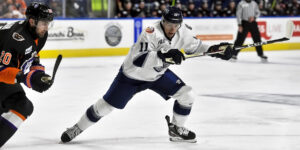

3 thoughts on “ECHL: 2024-25 End of Season Review | Atlanta Gladiators”